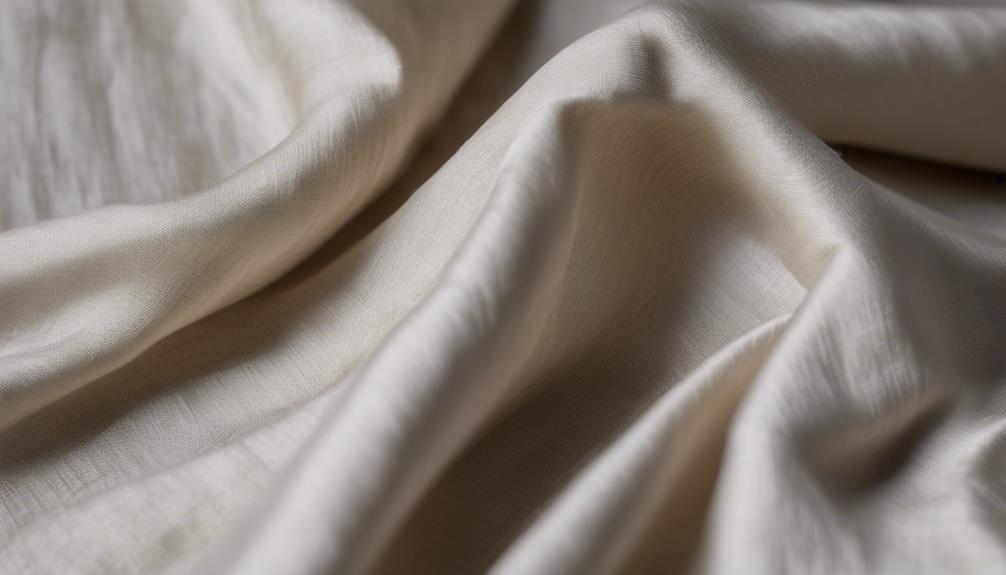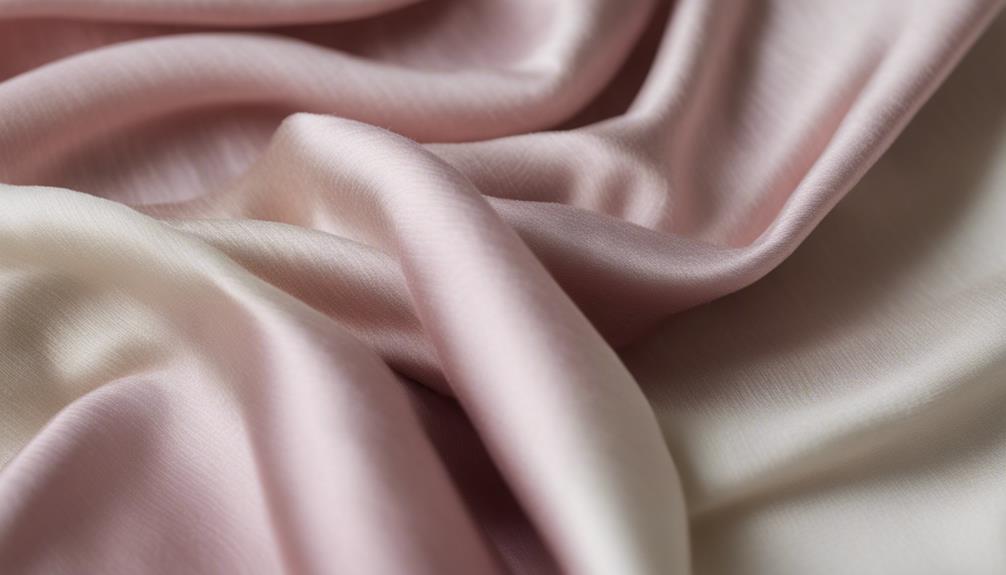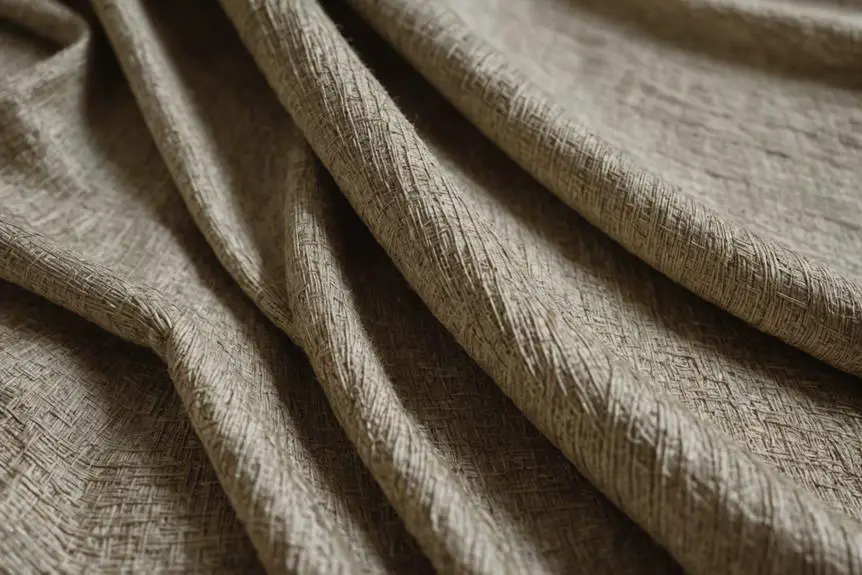When you want to identify Eri silk fabric, start by examining its unique texture and sheen. You'll notice it's slightly coarse yet surprisingly soft, with a natural sheen that reflects light beautifully. Holding the fabric up to light can reveal its translucency, and color variations can range from milky-white to reddish-orange. But there's more to take into account—how does it compare to other fabrics? And what about authenticity? Understanding these aspects is essential, as they can greatly influence your choice. So, what's the next step in this careful assessment?
Understanding Eri Silk Characteristics

When it comes to identifying Eri silk fabric, you'll notice it has a distinct soft yet slightly coarse texture that sets it apart from the smoother Mulberry silk. This unique texture isn't just for show—it's part of what makes Eri silk such a durable fabric! You'll appreciate how this fabric feels against your skin, especially since it's hypoallergenic. That means if you've got sensitive skin, Eri silk is a fantastic choice for you.
Now, let's talk about its unique appearance. Eri silk can range in color from milky-white to reddish-orange, and this variation depends on the diet of the silkworms. Pretty cool, right? You can spot Eri silk by its slight sheen that catches the light just right. Plus, since it's made from shorter fibers, it's resilient enough to be spun into both fine and heavier yarns.
Another great feature of Eri silk fabric is its breathability. It's perfect for any season because it helps regulate your temperature, keeping you comfy whether it's warm or cool outside. And guess what? Eri silk is processed without harsh chemicals, so you can wear it with peace of mind, knowing you're choosing natural fibers. So, next time you're on the hunt for fabric, remember these amazing characteristics of Eri silk. You'll be well on your way to becoming an Eri silk expert!
Visual and Textural Cues
Often, you'll notice that the visual and textural cues of Eri silk fabric are quite distinctive. When you're on the lookout for Eri silk, keep these key features in mind:
- Natural Sheen: Unlike other silk fabrics, Eri silk has a soft, subtle sheen that gives it a unique charm.
- Textural Feel: This fabric feels thicker and coarser than smoother silks, almost like linen. You might even say it's cozy!
- Color Variations: Eri silk comes in two main shades—milky-white and reddish-orange. This color difference usually comes from the silkworms munching on castor leaves.
When you touch Eri silk, you'll notice its slightly textured surface, which adds depth to its appearance. The fibers are shorter and have a more open structure, making this a breathable fabric that drapes beautifully without being overly shiny. If you hold it up to the light, you'll see a slight translucency, but don't expect it to shine like Mulberry silk.
All these visual and textural cues come together to create a fabric that's not just soft and comfortable, but also durable. So, the next time you're shopping for silk, remember these tips and you'll be able to spot Eri silk with confidence! Isn't it great to know what to look for?
Comparing Eri Silk With Other Fabrics

Eri silk stands out distinctly when compared to other fabrics, such as Mulberry silk or cotton. You might wonder, what makes it so special? Well, Eri silk comes from the Samia Cynthia Ricini moth, unlike Mulberry silk which is produced by the Bombyx Mori moth. This means Eri silk has a softer texture and a unique look because it's made from non-continuous silk fibers found in open-mouthed cocoons. Pretty cool, right?
When it comes to hypoallergenic properties, Eri silk is a winner. If you have sensitive skin, you'll appreciate how gentle it is compared to cotton, which, while comfy, doesn't have the same skin-friendly vibe. Plus, Eri silk has fantastic thermal properties. It keeps you cool in the summer and warm in the winter. Cotton? It usually just keeps things cool by pulling heat away from you.
Now, let's chat about dyeability. Eri silk takes color beautifully, giving you vibrant, long-lasting hues, while cotton can't quite match that. Just a heads up, though—Eri silk doesn't hold up as well in bright sunlight, so consider that for your wardrobe.
Testing for Authenticity
Testing for authenticity is essential when you're looking to invest in Eri silk fabric. You don't want to end up with something that's just pretending to be pure silk, right? Luckily, there are some simple tests you can do to guarantee you're getting the real deal.
Here are three easy methods to check for authenticity:
- Burn Test: Light a small piece of the fabric. Eri silk burns slowly, curls up, and smells like burning hair. If it melts, you've got a synthetic impostor on your hands!
- Chemical Test: Mix a little fabric with a 5% Sodium Hydroxide solution. Eri silk will dissolve slowly, while synthetic fibers won't budge. It's a great way to reveal the true nature of those fibers.
- Silk Mark Certification: Look for the Silk Mark tag. This guarantees that your fabric is pure Eri silk and that it's produced ethically. It's like a badge of honor for your fabric!
Caring for Eri Silk Fabric

Once you've guaranteed your fabric is authentic, caring for Eri silk is straightforward and rewarding. You'll love that Eri silk is washable, which makes maintenance a breeze! Just hand-wash it in cold water with a mild detergent. This way, you'll keep the fabric's quality intact and your skin happy, thanks to its hypoallergenic nature.
To keep your Eri silk looking fabulous, air-dry it in the shade. Seriously, don't let it bask in direct sunlight; it can fade faster than your favorite summer tan! And if you notice a few wrinkles, don't panic. Iron it at a low temperature while it's still slightly damp for that smooth finish you crave.
Storing your Eri silk garments properly is just as important. Keep them in a cool, dry place, away from those pesky sunlight rays. Want to keep them fresh longer? Use breathable fabric bags to store your treasures. Trust me, your Eri silk will thank you!
Cleaning it regularly is key, too. Even though it's hypoallergenic, a little dirt or oil buildup can sneak in, so keep it fresh. With these simple tips, you'll not only maintain the beauty of your Eri silk but also enjoy the natural elegance it brings to your wardrobe. Isn't it nice to know that taking care of your fabric can be so easy? Now go ahead and show off that stunning Eri silk!
Frequently Asked Questions
How to Identify Eri Silk?
So, you wanna identify Eri silk? First, feel the fabric; it's soft but has a slightly coarse texture. Check the colors too—they range from milky-white to reddish-orange. Don't forget the patterns! Eri production is unique, with Eri weavers creating this amazing fabric from open-mouthed cocoons. And the benefits? It's great for temperature regulation! With proper Eri care, you can enjoy its beauty for years. Isn't that cool?
What Are the Characteristics of Eri Silk?
Eri silk's got some amazing properties! Originating from the Eri silkworm, this fabric's soft texture feels great against your skin. You'll love its durability and breathability, making it perfect year-round. Plus, it's hypoallergenic—ideal for sensitive folks! Eri silk dyes beautifully too, offering colors from milky-white to reddish-orange. And with its sustainable production, you're helping the planet. Care for it right, and you'll enjoy its benefits for years! Isn't that awesome?
How Can You Tell What Kind of Silk You Have?
So, you're wondering how to tell what kind of silk you've got? First, check the fabric texture—Mulberry silk's shiny, while Eri's softer and more matte. Look for color variations, too; Eri's got those lovely milky-white or reddish-orange hues. Care instructions can clue you in, as different silk types require different treatments. Keep an eye on market pricing and fashion trends, since that can also signal which silk you're dealing with. Exciting, right?
Which Test Is the Best Way to Identify Silk?
Wanna know the best way to identify silk? The burn test is a classic! Just light a small piece; real silk burns slowly and smells like burnt hair. You can also try the touch test—silk feels so smooth and cool. Don't forget the shine test; it's got that beautiful luster. The sound test is fun too—genuine silk makes a soft rustling sound. So grab some fabric and give these tests a whirl!
Conclusion
So, there you have it! Identifying Eri silk isn't just about being fancy; it's about appreciating that unique texture and shine. Whether you're checking for that milky-white or reddish-orange hue, or doing the burn test, you're on the right track. Remember, caring for your Eri silk helps keep it gorgeous for years. So, are you ready to rock that beautiful fabric? Plunge into it, and let your wardrobe glow with the charm of Eri silk!




